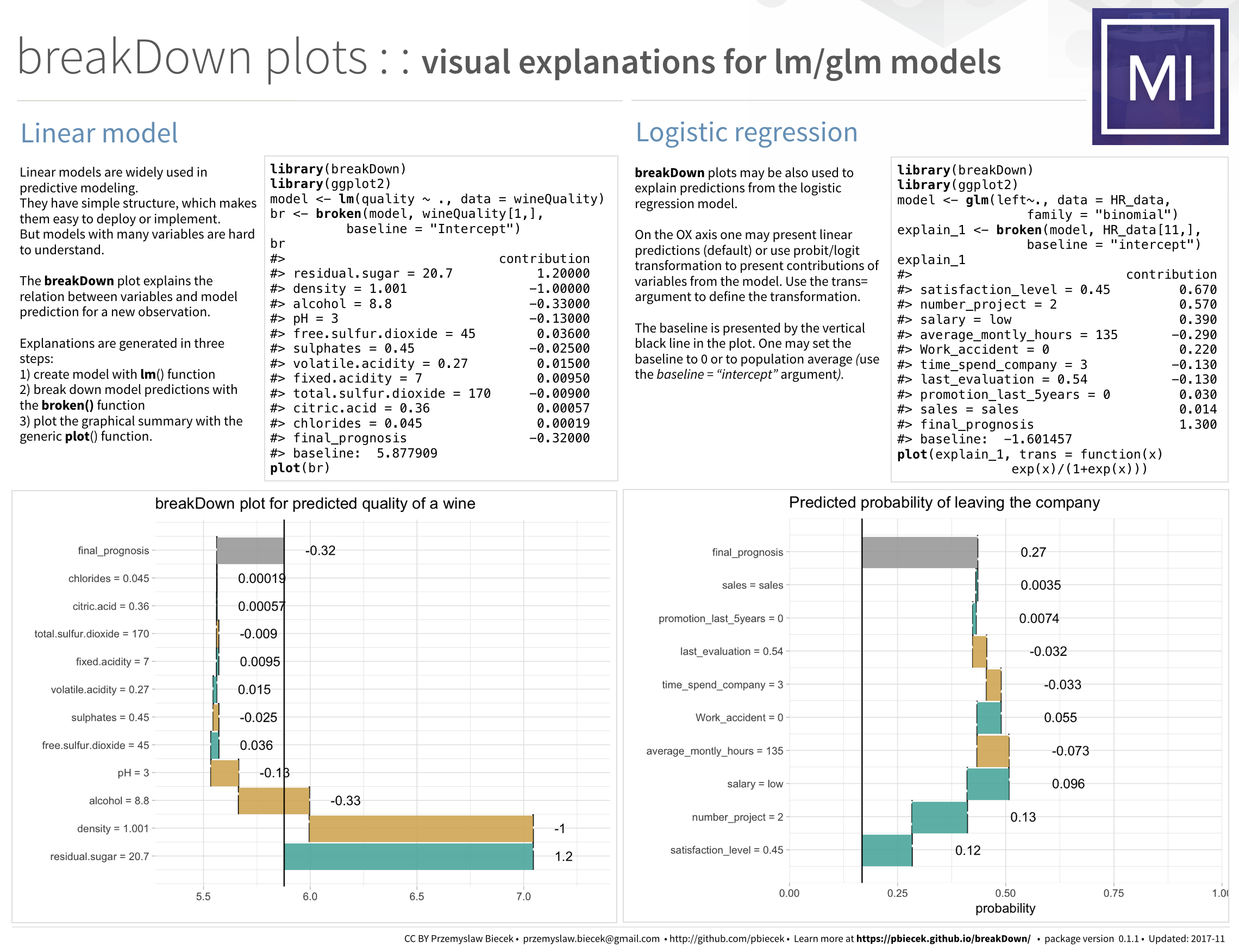https://github.com/pbiecek/breakdown
Model Agnostics breakDown plots
https://github.com/pbiecek/breakdown
data-science iml interpretability machine-learning visual-explanations xai
Last synced: 6 months ago
JSON representation
Model Agnostics breakDown plots
- Host: GitHub
- URL: https://github.com/pbiecek/breakdown
- Owner: pbiecek
- Created: 2017-11-18T09:37:00.000Z (almost 8 years ago)
- Default Branch: master
- Last Pushed: 2024-03-12T21:20:53.000Z (over 1 year ago)
- Last Synced: 2025-04-02T03:38:01.628Z (6 months ago)
- Topics: data-science, iml, interpretability, machine-learning, visual-explanations, xai
- Language: R
- Homepage: https://pbiecek.github.io/breakDown/
- Size: 20.2 MB
- Stars: 103
- Watchers: 11
- Forks: 16
- Open Issues: 7
-
Metadata Files:
- Readme: README.md
- Changelog: NEWS.md
Awesome Lists containing this project
README
[](https://cran.r-project.org/package=breakDown)
[](http://cran.rstudio.com/package=breakDown)
[](http://cranlogs.r-pkg.org/badges/grand-total/breakDown)
[](https://travis-ci.org/pbiecek/breakDown)
[](https://codecov.io/github/pbiecek/breakDown?branch=master)
# Break Down: Model Agnostic Explainers for Individual Predictions
The `breakDown` package is a model agnostic tool for decomposition of predictions from black boxes.
Break Down Table shows contributions of every variable to a final prediction.
Break Down Plot presents variable contributions in a concise graphical way.
This package works for binary classifiers and general regression models.
Find lots of R examples at `breakDown` website: https://pbiecek.github.io/breakDown/
Interested in the methodology? Find the math behind `breakDown` and `live` at: https://arxiv.org/abs/1804.01955
Looking for the `python` version of Break Down? Find it here: https://github.com/bondyra/pyBreakDown
**New generation of the Break-Down algorithm is implemented in the iBreakDown package
https://github.com/ModelOriented/iBreakDown**. All new features will be added to the iBreakDown.
## Installation
Install from CRAN
```
install.packages("breakDown")
```
Install from GitHub
```
devtools::install_github("pbiecek/breakDown")
```
## Cheatsheets

## Example for lm model
Get data with [archivist](https://github.com/pbiecek/archivist)
* broken object: `archivist::aread("pbiecek/breakDown/arepo/81c5be568d4db2ec795dedcb5d7d6599")`
* the plot: `archivist::aread("pbiecek/breakDown/arepo/7b40949a0fdf9c22780454581d4b556e")`
The R code
```{r}
library(breakDown)
url <- 'https://archive.ics.uci.edu/ml/machine-learning-databases/wine-quality/winequality-white.csv'
wine <- read.table(url, header = T, sep=";")
head(wine, 3)
## fixed.acidity volatile.acidity citric.acid residual.sugar chlorides free.sulfur.dioxide total.sulfur.dioxide density pH
## 1 7.0 0.27 0.36 20.7 0.045 45 170 1.0010 3.00
## 2 6.3 0.30 0.34 1.6 0.049 14 132 0.9940 3.30
## 3 8.1 0.28 0.40 6.9 0.050 30 97 0.9951 3.26
## sulphates alcohol quality
## 1 0.45 8.8 6
## 2 0.49 9.5 6
## 3 0.44 10.1 6
model <- lm(quality ~ fixed.acidity + volatile.acidity + citric.acid + residual.sugar + chlorides + free.sulfur.dioxide + total.sulfur.dioxide + density + pH + sulphates + alcohol,
data = wine)
new_observation <- wine[1,]
br <- broken(model, new_observation)
br
## contribution
## (Intercept) 5.90000
## residual.sugar = 20.7 1.20000
## density = 1.001 -1.00000
## alcohol = 8.8 -0.33000
## pH = 3 -0.13000
## free.sulfur.dioxide = 45 0.03600
## sulphates = 0.45 -0.02500
## volatile.acidity = 0.27 0.01500
## fixed.acidity = 7 0.00950
## total.sulfur.dioxide = 170 -0.00900
## citric.acid = 0.36 0.00057
## chlorides = 0.045 0.00019
## final_prognosis 5.60000
plot(br)
```
